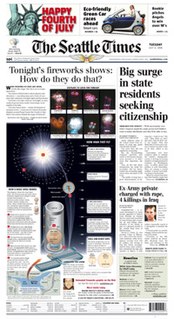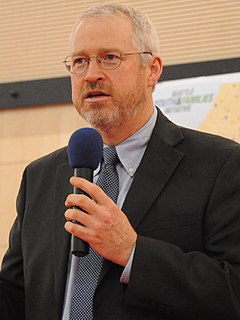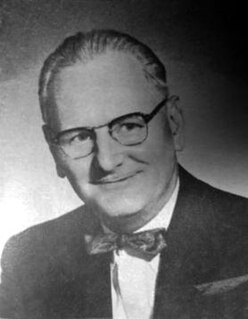Related Research Articles

The Seattle Times is a daily newspaper serving Seattle, Washington, United States. It was founded in 1891 and has been controlled by the Blethen family since 1896. The Seattle Times has the largest circulation of any newspaper in Washington state and the Pacific Northwest region.

The Fremont Troll is a public sculpture in the Fremont neighborhood of Seattle, Washington in the United States.

Northwest Folklife is an independent 501(c)(3) arts organization that celebrates the multigenerational arts, cultures, and traditions of a global Pacific Northwest. Since 1972, Northwest Folklife has been deeply committed to celebrating the diversity of our Northwest communities and demystifying our differences together, under one roof.

The Flaming Geyser State Park is located on the Green River in southwestern King County, Washington, near the city of Black Diamond. The park was named for a flame which burned through a concrete basin, fueled by a methane gas pocket 1,000 feet below the surface. When the pocket was discovered by prospective coal miners in the early 1900s, the test hole hit gas and saltwater, shooting water and flames 25 feet into the air. The same methane pocket seeps gas through a mud hole to create the "Bubbling Geyser" nearby. Both "geysers" can be found along a short hike, though as of 2016 the flaming geyser is no longer lit due to depletion of its methane source.
Nightmare Theatre was one of the more prominent late-night horror programs of the 1960s and 1970s. During its fourteen-year run, this show introduced several generations of television viewers to the horror films of yesteryear across the Pacific Northwest. Produced by Seattle-based KIRO-TV, and utilizing much of the same cast and crew as the similarly popular The J.P. Patches Show, Nightmare Theatre reached an audience that stretched as far north as Alaska, as far east as Idaho, and south into Oregon, as well as Canada. Its residential horror host, The Count, has accrued a cult following over the years, much in the same vein as his make-up laden peers Maila Nurmi ("Vampira"), John Zacherle ("Zacherley"), and Cassandra Peterson ("Elvira").

The 2009 Seattle mayoral election took place November 3, 2009.

On New Year's Day 2001, a replica of the Monolith from 2001: A Space Odyssey appeared on Kite Hill in Seattle's Magnuson Park. The Seattle Monolith was a guerrilla art installation by a group of Seattle artists calling themselves "Some People."

Caleb David Schaber was an American artist and journalist best known for his participation in the Seattle Monolith project at the beginning of 2001 and his run for mayor of Seattle later that same year.
Seattle Community Access Network (SCAN) is one of the Public, educational, and government access (PEG) cable television channels in Seattle, Washington. The station provides camera equipment, television studios and training that allow residents of King County to create and cablecast their own television shows for a small fee. The station is carried on Comcast and Broadstripe cable systems in King County and the greater Puget Sound region except for six cities covered by Puget Sound Access.
Huw Edwards is a Welsh conductor. Edwards' conducting career began at age seventeen when he became music director of the Maidstone Opera Company in England. He later attended the University of Surrey, where he conducted the college orchestra along with an ensemble that he formed himself. At age twenty-three, he won a conducting competition which sent him to Southern Methodist University in Dallas, Texas. He then held a lecturer position at Northwestern University in Chicago, where he was also a doctoral candidate. Edwards was conductor and music director of the Portland Youth Philharmonic from 1995 to 2002 followed by the Seattle Youth Symphony from 2002 to 2005. He served as music director of the Portland Columbia Symphony from 2000 to 2012 and with the Olympia Symphony Orchestra from 2003 to 2020.

Meydenbauer Bay Park is a park located in Bellevue, Washington along Lake Washington. Named after William Meydenbauer, the park features paved and unpaved trails, picnic tables, a playground, a restroom facility and a beach.

The 2012 Washington Republican presidential caucuses were held on March 3, 2012. Since 1992, the Washington Republicans have used a presidential preferential primary in addition to the caucuses. The 2012 primary was, however, canceled for budgetary reasons, as was the one in 2004.

Ukrainian Association of Washington State is a regional non-profit organization that represents cultural and social interests of Americans of Ukrainian origin, promotes understanding between Americans and Ukrainians, and supports Ukrainian cultural and scientific centers worldwide.

The Concrete Herald is a newspaper serving the town of Concrete, Washington, United States, along with other communities in surrounding Skagit County. The newspaper has received multiple awards from the Washington Newspaper Publishers' Association, Washington State Press Club, and various other state and local organizations. The Herald's publications have initiated various public projects in the area and played the key role in fighting industrial pollution in Concrete. The newspaper serves as a cohesive element for the community of the Upper Skagit Valley. Previously published as a weekly newspaper from 1901 until its dissolution in 1991, The Concrete Herald was relaunched as a monthly publication in 2009.

Charles "Chuck" Muth Dwelley was a community activist of Skagit County and the owner and the editor in chief of The Concrete Herald newspaper for over forty years from 1929 to 1970. Many of his editorials were quoted nationwide in Reader's Digest, The New York Times, etc. and occasionally referred among professional journalists as "Dwellisms". He served as the president of the Washington State Publishers' Association in 1957–58, received multiple awards in journalism, and repeatedly represented Washington state in National Editorial Association.

Pacific Marine Review was an American monthly magazine published from 1904 to 1950 dedicated to marine and shipping news. The magazine aimed to cover marine affairs in Seattle, Portland, Tacoma, Vancouver, Victoria, San Francisco and other ports on the North Pacific Ocean impartially, without preference for any particular port.

The Minnie A. Caine was a four-masted wooden schooner built by Seattle shipbuilder Moran Brothers in 1900. One of the schooner's initial short-term co-owners, Elmer Caine, named her after his wife Minnie. From 1900 to 1926, the schooner was operated out of San Francisco by Charles Nelson Co., one of the largest transporter of lumber in United States at the time. The schooner transported lumber across the Pacific Ocean from the Pacific Northwest to ports of Australia and Americas, but after 1920 her scope of operations became limited to West Coast lumber trade. By 1926, the company no longer could run a sailing ship with profit, and the Minnie A. Caine was moored in boneyard in California.

The Star of Bengal was an iron three-masted 1,877 GT merchant sailing vessel built in Belfast in 1874 by Harland and Wolff Industries, the shipyard that later constructed the Titanic. Although built towards the decline of the Age of Sail, the Star of Bengal was successfully operated for 24 years by the British trading company J.P. Corry & Co. The ship was mainly used on London-Calcutta trading route, but also made a few voyages to Australian and American ports.

John Leary was an American businessman and politician who was a key civic leader in Seattle, Washington. He made contributions to virtually all civic and business activities during the city's early years.
Madison Pub is a gay bar in Seattle, Washington, United States.
References
- 1 2 3 4 Brunner, Jim; Young, Bob (September 6, 2005). "Six little-known opponents facing Nickels in primary". The Seattle Times . Seattle, Washington, USA: Frank A. Blethen. ISSN 0745-9696. OCLC 9198928 . Retrieved April 22, 2012.
- ↑ Campbell, Phil (2005). Zioncheck for President: A True Story of Idealism and Madness in American Politics . New York City, USA: Nation Books. ISBN 978-1-56025-750-9. OCLC 61718230.
- ↑ Campbell, Phil (November 21, 2002). "Insane Determination. Richard Lee's Wild Ride Through Nirvana Fictions". The Stranger . Seattle, Washington, USA: Tim Keck. ISSN 1935-9004. OCLC 27341179 . Retrieved April 22, 2012.
- ↑ Brunner, Jim (July 14, 2005). "Mayoral hopeful seeks to conceal donors". The Seattle Times . Seattle, Washington, USA: Frank A. Blethen. ISSN 0745-9696. OCLC 9198928 . Retrieved April 22, 2012.
- ↑ New York Times (April 19, 1983). "Chicago reviews ban on street performers". Minneapolis Star and Tribune .
- ↑ Anderson, Rick (August 25, 1999). "Dreamers, schemers, and kooks. The annual rite of running and losing". Seattle Weekly . Seattle, Washington, USA: Ken Stocker. ISSN 0898-0845. OCLC 17527271. Archived from the original on March 4, 2016. Retrieved April 22, 2012.
- ↑ Staff (July 28, 2001). "King County election filings". The Seattle Times . Seattle, Washington, USA: Frank A. Blethen. ISSN 0745-9696. OCLC 9198928 . Retrieved April 22, 2012.
- ↑ Forgrave, Reid (September 8, 2001). "Enthusiasm meets obscurity: Colorful supporting cast fills out ballot in mayor's race". The Seattle Times . Seattle, Washington, USA: Frank A. Blethen. ISSN 0745-9696. OCLC 9198928 . Retrieved April 22, 2012.
- ↑ Brunner, Jim (August 28, 2001). "Candidates forum mixes comedy, pinch of politics". The Seattle Times . Seattle, Washington, USA: Frank A. Blethen. ISSN 0745-9696. OCLC 9198928 . Retrieved April 22, 2012.
- ↑ "Love 'stalker' arrested". United Press International . UPI. January 12, 2005. Retrieved April 22, 2012.
- ↑ Staff (September 8, 2005). "Mayoral candidate arrested". Seattle Post-Intelligencer . Seattle, Washington, USA: Roger Oglesby. ISSN 0745-970X. OCLC 3734418 . Retrieved April 22, 2012.
Sources
- Brown, Mark (May 2, 1996). "Web debate nurtures eerie Cobain murder theory". Milwaukee Journal Sentinel . Milwaukee, Wisconsin. USA: Elizabeth Brenner. p. 122. ISSN 1082-8850. OCLC 55506548 . Retrieved April 22, 2012.
- Axmaker, Sean (August 3, 2005). "Gus Van Sant: "A cinema that might have existed"". GreenCine. All Media Guide. Archived from the original on January 25, 2013. Retrieved April 22, 2012.
- Mulady, Kathy (July 29, 2005). "7 candidates to go up against Nickels in mayor's race". Seattle Post-Intelligencer . Seattle, Washington, USA: Roger Oglesby. ISSN 0745-970X. OCLC 3734418 . Retrieved April 22, 2012.
- Rolph, Amy (October 25, 2011). "Duff McKagan to Kurt Cobain conspiracy theorist: 'Get the (bleep) out'". Seattle Post-Intelligencer . Seattle, Washington, USA: Roger Oglesby. ISSN 0745-970X. OCLC 3734418 . Retrieved April 22, 2012.
- Jenniges, Amy (October 4, 2001). "KING OF THE DIPSH*TS". The Stranger . Seattle, Washington, USA: Tim Keck. ISSN 1935-9004. OCLC 27341179 . Retrieved April 22, 2012.
- Staff (August 3, 2005). "Candidates Line Up For City Elections". West Seattle Herald . Seattle, Washington, USA: Jerry Robinson. p. 2. ISSN 2160-3642. OCLC 304627581 . Retrieved April 22, 2012.
- Sorbo, Cathy (August 5, 2005). "Curious voters need more info". Seattle Post-Intelligencer . Seattle, Washington, USA: Roger Oglesby. ISSN 0745-970X. OCLC 3734418 . Retrieved April 22, 2012.
- Brunner, Jim (September 8, 2005). "Mayoral hopeful accused of kicking Nickels' guard". The Seattle Times . Seattle, Washington, USA: Frank A. Blethen. ISSN 0745-9696. OCLC 9198928 . Retrieved April 22, 2012.
- Staff (October 24, 2005). "Mayoral restraint". The Seattle Times . Seattle, Washington, USA: Frank A. Blethen. ISSN 0745-9696. OCLC 9198928 . Retrieved April 22, 2012.